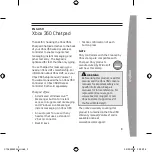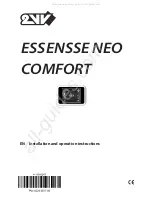
26
7 Set up with the integrated display and adjustment unit
VEGAMET 861 • 4 … 20 mA/HART
58866-EN-200401
•
PV (Primary Value)
•
SV (Secondary Value)
•
TV (Tertiary Value)
•
QV (Quarterly Value)
The prerequisite for this is the support of the HART commands 0, 1, 3
and 15. This information and which measured values are transferred
must be taken from the operating instructions manual of the respec-
tive sensor manufacturer.
After selecting the input type "
HART
", perform a sensor search first.
All connected HART sensors are then listed and you can select the
desired sensor. Then you can define the appropriate
Sensor value
. In
the menu item "
Sensor info
" information such as sensor type, measur-
ing range, serial number, HART address, measuring range, sensor
TAG, … are available.
To suppress fluctuations in the measured value display, e.g. caused
by an agitated medium surface, an integration time can be set. This
time can be between 0 and 99 seconds. Remember that the reaction
time of the entire measurement will then be longer and the sensor will
react to measured value changes with a delay. In general, a period of
a few seconds is sufficient to smooth the measured value display.
A linearisation is necessary for all vessels in which the vessel volume
does not increase linearly with the level, for example a horizontal
cylindrical or spherical tank. Corresponding linearisation curves are
preprogrammed for these vessels. They represent the correlation
between the level percentage and vessel volume. By activating the
appropriate curve, the volume percentage of the vessel is displayed
correctly. If the volume should not be displayed in percent but e.g. in l
or kg, a scaling can be also set.
When setting up a flow measurement, a linearization curve suitable
for the structural conditions must be selected. Corresponding curves
such as venturi, triangular overflow, … are available here. In addition,
individual, user-programmable linearisation curves can be stored via
DTM.
Through the adjustment the input value of the connected sensor is
converted into a percentage value. This conversion step allows any
input value range to be depicted in a relative range (0 % up to 100 %).
The percentage values can be used for presentation on the display,
for direct use in an output or for further conversion via linearization or
scaling.
When using the display and adjustment unit, the adjustment unit is
always "
mA
". When using PACTware/DTM or the VEGA Tools app,
further units can be selected. If these have been activated, they are
also shown in the display.
Min. adjustment (empty vessel)
If you want to use the currently measured level as a 0 %value, select
the menu item "
Accept
" (live adjustment or adjustment with medium).
If the adjustment is to be carried out independently of the measured
level, select the option "
Edit
". Now enter the appropriate current in
Damping
Linearisation
Adjustment
















































